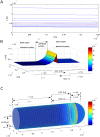Persistent symmetry frustration in pollen tubes
- PMID: 23144847
- PMCID: PMC3489839
- DOI: 10.1371/journal.pone.0048087
Persistent symmetry frustration in pollen tubes
Abstract
Pollen tubes are extremely rapidly growing plant cells whose morphogenesis is determined by spatial gradients in the biochemical composition of the cell wall. We investigate the hypothesis (MP) that the distribution of the local mechanical properties of the wall, corresponding to the change of the radial symmetry along the axial direction, may lead to growth oscillations in pollen tubes. We claim that the experimentally observed oscillations originate from the symmetry change at the transition zone, where both intervening symmetries (cylindrical and spherical) meet. The characteristic oscillations between resonating symmetries at a given (constant) turgor pressure and a gradient of wall material constants may be identified with the observed growth-cycles in pollen tubes.
Conflict of interest statement
Figures



 (color bar) visualized on the pollen tube surface (C). Symmetry change induces frustration at the transition ‘a’ zone (A) – a red (dash-dotted) line immersed in the blue background.
(color bar) visualized on the pollen tube surface (C). Symmetry change induces frustration at the transition ‘a’ zone (A) – a red (dash-dotted) line immersed in the blue background.



Similar articles
-
Pressure-induced cell wall instability and growth oscillations in pollen tubes.PLoS One. 2013 Nov 19;8(11):e75803. doi: 10.1371/journal.pone.0075803. eCollection 2013. PLoS One. 2013. PMID: 24260097 Free PMC article.
-
Chemically mediated mechanical expansion of the pollen tube cell wall.Biophys J. 2011 Oct 19;101(8):1844-53. doi: 10.1016/j.bpj.2011.08.016. Biophys J. 2011. PMID: 22004737 Free PMC article.
-
Finite element model of polar growth in pollen tubes.Plant Cell. 2010 Aug;22(8):2579-93. doi: 10.1105/tpc.110.075754. Epub 2010 Aug 10. Plant Cell. 2010. PMID: 20699395 Free PMC article.
-
The cellular mechanics of an invasive lifestyle.J Exp Bot. 2013 Nov;64(15):4709-28. doi: 10.1093/jxb/ert254. Epub 2013 Sep 7. J Exp Bot. 2013. PMID: 24014865 Review.
-
The role of pectin in plant morphogenesis.Biosystems. 2012 Sep;109(3):397-402. doi: 10.1016/j.biosystems.2012.04.006. Epub 2012 Apr 24. Biosystems. 2012. PMID: 22554809 Review.
Cited by
-
Polar Expansion Dynamics in the Plant Kingdom: A Diverse and Multifunctional Journey on the Path to Pollen Tubes.Plants (Basel). 2013 Mar 18;2(1):148-73. doi: 10.3390/plants2010148. Plants (Basel). 2013. PMID: 27137370 Free PMC article. Review.
-
Frequency-associated transition from single-cell asynchronous motion to monotonic growth.J Biol Phys. 2017 Dec;43(4):461-470. doi: 10.1007/s10867-017-9462-7. Epub 2017 Sep 12. J Biol Phys. 2017. PMID: 28900825 Free PMC article.
-
Power spectrum, growth velocities and cross-correlations of longitudinal and transverse oscillations of individual Nicotiana tabacum pollen tube.Planta. 2014 Aug;240(2):263-76. doi: 10.1007/s00425-014-2083-5. Epub 2014 May 11. Planta. 2014. PMID: 24817588 Free PMC article.
-
Pressure-induced cell wall instability and growth oscillations in pollen tubes.PLoS One. 2013 Nov 19;8(11):e75803. doi: 10.1371/journal.pone.0075803. eCollection 2013. PLoS One. 2013. PMID: 24260097 Free PMC article.
-
Form matters: morphological aspects of lateral root development.Ann Bot. 2013 Dec;112(9):1643-54. doi: 10.1093/aob/mct231. Epub 2013 Nov 4. Ann Bot. 2013. PMID: 24190952 Free PMC article. Review.
References
-
- Feijó JA, Sainhas J, Holdaway-Clarke TL, Cordeiro MS, Kunkel JG, et al. (2001) Cellular oscillations and the regulation of growth: the pollen tube paradigm. Bioessays 23: 86–94. - PubMed
-
- Chebli Y, Geitmann A (2007) Mechanical principles governing pollen tube growth. Funct. Plant Sci. Biotechnol. 1: 232–245.
-
- Li Y-Q, Fang C, Faleri C, Ciampolini F, Linskens HF, et al. (1995) Presumed phylogenetic basis of the correlation of pectin deposition pattern in pollen tube walls and the stylar structure of angiosperms. Proc Kon Ned Akad v Wetensch 98: 39–44.
-
- Zonia L, Munnik T (2007) Life under pressure: hydrostatic pressure in cell growth and function. Trends Plant Sci 12: 90–97. - PubMed
Publication types
MeSH terms
LinkOut - more resources
Full Text Sources

